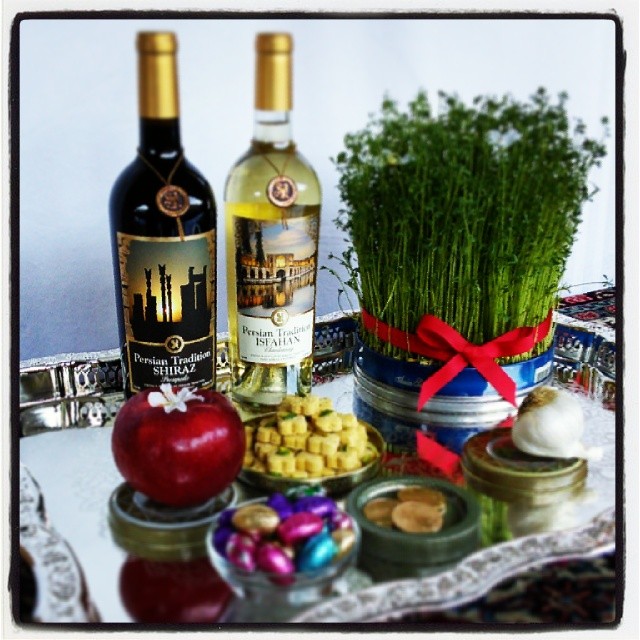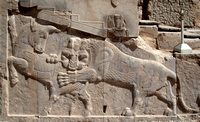Nowrūz ( نوروز ) (New Day) is the name of the Iranian New year in the Persian calendar.
Nowruz is also referred to as the "Persian New Year".
Norooz in Los Angeles Time (PST*) :
Nowruz is March 20th at 8:33 AM
Nowruz marks the first day of spring and the beginning of the year in the Iranian calendar. It is celebrated on the day of the astronomical Northward equinox, which usually occurs on March 21 or the previous/following day depending on where it is observed.
Originally being a Zoroastrian festival, and the holiest of them all, Nowruz is believed to have been invented by Zoroaster himself, although there is no clear date of origin. Since the Achaemenid era the official year has begun with the New Day when the Sun leaves the zodiac of Pisces and enters the zodiacal sign of Aries, signifying the Spring Equinox.
The term Nowruz in writing first appeared in Persian records in the 2nd century AD, but it was also an important day during the time of the Achaemenids (c. 550–330 BCE), where kings from different nations under the Persian empire used to bring gifts to the Emperor, also called King of Kings (Shahanshah), of Persia on Nowruz.
Read more about Nowruz and the meaning behind the haft sin
How better to celebrate Nowruz; than with friends and Persian Tradition wine.
Take 15 % off all wine in the online shop with coupon code: Nowruz
To answer the question: ''What is Nowruz? (or is it Norooz ?) ''; we present this beatiful article:
In Search of the Haft Sin
by Farhad Mohit
Search for the meaning behind the haft sin
My search for the meaning behind the haft sin table started years ago when I asked myself a simple question: If haft sin refers to “haft” (the number seven), and “sin” (the Persian letter “S”) why are there more than seven items on the table and why don’t many of their names start with “S?” What is the extra stuff? And, why set this table as part of the Nowruz (Persian New Year) celebration which happens at the Spring equinox each year)?
The haft sin, comes from “haft shin”
I asked friends, family, learned people… and basically got back a variety of explanations that always followed the same internally inconsistent plotline, which goes something like this: The haft sin, comes from “haft shin”, which means “haft” (or seven) and “shin” or the Persian letter “Sh”… Somehow, through the passage of time and for reasons entirely unknown to everyone who recites this story, the “shin” has changed to “sin” and now we have the haft sin, which again refers to the “haft” (or seven), but this time to “sin”, or the Persian letter, “S”.
Unfortunately, even though everyone seems to agree on this explanation, this story is ridiculous on the face of it. After all, everyone knows and acknowledges that there are several essential symbols that must be on every haft sin table, but that don’t start with a “sin.” Notebly, these symbols are Sham (candle), Ayeneh (mirror), Mahee (fish), and Tokhmeh Morgh (Eggs).
Also, there are many more than seven “sins” that are commonly included on the spread. In fact, the Encyclopedia Iranica and Wikipedia count fifteen between the two of them:
- sabzeh – wheat, barley or lentil sprouts growing in a dish
- samanu – a sweet pudding made from wheat germ
- senjed – the dried fruit of the oleaster tree
- sîr – garlic
- sîb – apples
- somaq – sumac berries
- serkeh – vinegar
- sonbol – the fragrant hyacinth flower
- sekkeh – coins
- sohan – brittles made of granulated sugar and honey enriched with saffron
- sabzi – a dishful of fresh herbs
- sangak - a very hard pea-like grain
- siyah dana – fennel
- sepestan – sebestan
- sorma – collyrium
Why is the haft sin associated with Spring
So, what is the real story? And why is the haft sin associated with Spring and the celebration of renewal that is core to the symbolism of the Persian New Year (Nowruz)?
I continued to wonder about this, at least once a year, until I started going to a Persian poetry class taught by a very learned teacher who broke it down for me in a way that finally made sense:
The haft sin is composed of “haft” (or seven) essential symbols, and “sin” which may have been shortened from “sini” (or trays), which held these essential symbols.
The symbols break down into three from the material world (or “donyaheh mahdoodiat”), three from the conceptual world (or “donayeh maanah”), and one that sits between and ties the two worlds together.
Symbols of the Material world:
- sang – stone – symbol of matter, the lowest form of the material world
- sabzeh – grass – wheat, barley or lentil sprouts growing in a dish – symbol of the vegetable world and of re-birth
- tokhmeh morgh – egg – decorated with designs – symbol of the animal kingdom and of fertility
Symbols of the Conceptual world:
- sham – candle – symbol of the light of being, energy or the creative force
- ayehneh – mirror – symbol of the field of possibilities where the creative force reflects and makes everything possible
- mahee – fish in water – symbol the infinite (water) and life within it (fish)
Sharab – wine – symbol of the human, with the jug or glass as the body
Symbol that ties the two together:
- sharab – wine – symbol of the human, with the jug or glass as the body (material) and the wine as the spirit (conceptual)
Taken as a group these symbols show a progression from the material to the spiritual, with stone (matter) at the lowest end, and candle (energy) at the highest, and the wine (human) in the middle, connecting these two worlds together. So, this is the point of the haft sin, to remind us of our purpose as humans in this world; the idea that we are here to not only experience limitation and the material world, but also to experience transcendence and higher consciousness in the spiritual or conceptual realm.
The haft sin is a symbolic reminder of the constant renewal
How does one do that? Well, that’s where the whole thing ties into the celebration of Nowruz, which is all about renewal and the start of Spring. The haft sin is a symbolic reminder of the constant renewal (or rebirth) that can happen when one transcends and balances the material (mind), with the immaterial (spirit), by letting life flow through oneself in a perpetual state of acceptance, amazement and appreciation of each moment as it happens.
We are matter and spirit, always becoming, aware of both aspects of ourselves in the present where everything happens. I call this the wow of now, where joy or “zogh” (as we Persians call it), lives.
Interestingly, and probably why this came up in our poetry class in the first place, such symbolism is foundational to much of the classical Iranian poetry and philosophy.
Whether we’re talking about Rumi or Hafez and their numerous odes to the dance between the material and spiritual worlds, or Ferdowsi and his epic masterpiece the Shahnameh (Letter to a King), which begins with a symbolic king, Kiumars, (whose description is that of Light) and ends with actual rulers and people of his day (the real and tangible), or even the dance of the Sufi whirling dervishes who always have one hand to the ground and one hand to the sky, spinning in order to negate space and time by facing all directions at once — a near perfect symbol of the striving towards unity of the material (or finite) and the spiritual / conceptual (or infinite) — Iranian culture always seems to revolve around and return to this symbolism.
The earth has turned about itself and is coming back to life
So, what more fitting celebration, than the start of Spring, where the earth has turned about itself and is coming back to life, for us to remind ourselves of the continuous renewal that happens when we balance our material part (our mind / ego) with our spiritual part (our consciousness) and transcend the boundaries of space and time into that perpetual state of renewal that is the moment, or the now.
At the end of the day, this is what being alive is about, and that is why I find the above explanation of the meaning of the essential symbols on the haft sin of the Persian New Year (NowRuz) so beautiful, clear and interesting.
—
Appendix / Additional Questions:
1) So what about the other symbols on the table, like a Koran or a book by Hafez, or Ferdowsi?
The story goes as follows… These seven sacred symbols have descended from pagan rituals that prevailed at or around the time of Zoroaster. There is a long-standing tradition in many pagan cults to speak in a hidden or symbolic language that is not readily discernible to the untrained ear of the uninitiated. Also, Iran has a long history of embracing invaders and their culture and traditions without abandoning its own foundations, beliefs or roots.
The above facts together with the Arab invasion of Iran which brought with it Islam about a thousand years ago, meant that the first thing that the “pagan” Persians did in order to preserve their tradition was to add a Koran in the middle of the haft sin. This meant that their sacred table would be sacred to Muslims too, and so their tradition could live on. Then over the course of time as some segments of society became more secular, some people started replacing the “holy book” of the Koran with one that they felt better represented their sense of spirituality, like the Divan of Hafez, or the Shahnameh of Ferdowsi.
2) What about two missing symbols that you claim are essential: sang (stone) and sharab (wine)? How come I have never seen these on a Haft sin?
This is a point that again ties to the last question regarding “hidden language”… Your eyes are deceiving you, for they are both on every haft sin table you have seen. Sang (stone) has, in our increasingly materialistic society, became sekkeh (coins, usually made of gold, most precious of materials, but “stone” nonetheless). And, with the Islamic existential threat to this originally pagan tradition, sharab (wine), which is not allowed by Islam, was replaced with serkeh (vinegar), so that it could be left on the spread without drawing too much fuss. So, these two essential symbols still exist on the haft sin; they’ve just been transformed to accommodate the prevailing socially acceptable norms of what is good, proper and acceptable.
3) And what of all the other “sin” symbols above? After all, they are all written about in the Encyclopedia Iranica and Wikipedia!
I cannot say for sure how they got onto the table, whether as a distraction for the untrained viewer, or for some other reason. Nor can I say with any conviction that makes my heart feel something, what their symbolic value is beyond the rather prosaic, mostly cliche and somewhat superstitious explanations given in the publications (like apple is for health, senjed is for love, garlic is to ward off evil, etc.)
I can say however, that whatever their purpose and meaning, these other items most certainly don’t distract me from the symbolic coherence of what the seven essential symbols on the haft sin represent and how they have finally allowed me to appreciate this wonderful tradition in a way that makes complete sense to me and makes my heart jump for joy at the prospect of a life lived as a perpetual celebration of being in the moment, or Nowruz!



